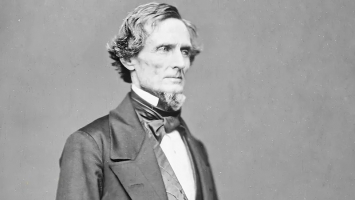Top 11 Interesting Facts about Thomas Jefferson
The Declaration of Independence, written by the third president of the United States, Thomas Jefferson (1743–1826), is one of the most important pieces of ... read more...contemporary literature. While it is unquestionably a highlight of his career, there is much more to him than that. Check out 11 interesting facts to learn more about Jefferson's life, accomplishments, and conflicts.
-
Jefferson was one of ten children born on April 13, 1743 (April 2 on the pre-Gregorian calendar), at his father's Shadwell farm in Virginia (eight of whom survived to adulthood). At Tuckahoe, Jefferson and the Randolph children started their educations together with tutors. Thomas' father Peter, a self-taught man who regretted not having had a formal education, enrolled his son in an English school when he was five years old. He started attending a local school operated by a Scottish Presbyterian preacher in 1752 when he was nine years old. He also started studying the natural environment, which he grew to love. He started learning Latin, Greek, and French at this time, as well as how to ride a horse. Thomas read books from his father's little collection as well. As time went on, Jefferson got to meet and became friends with a variety of American Indians, including the renowned Cherokee chief Ontasseté, one of the interesting facts about Thomas Jefferson.
At the age of 16, Jefferson enrolled at the College of William & Mary in Williamsburg, Virginia, where he studied philosophy, mathematics, and metaphysics under Professor William Small. Jefferson became acquainted with the theories of the British empiricists, such as John Locke, Francis Bacon, and Isaac Newton while studying under Small. Small introduced Francis Fauquier and George Wythe to Jefferson. Small, Wythe, and Fauquier welcomed Jefferson into their inner group after recognizing his outstanding talent. He soon joined them for Friday dinner gatherings where they debated politics and philosophy.
He was reported to have studied for 15 hours a day in addition to practicing the violin while he was a student at the College of William & Mary. He graduated in 1762. The effort paid off, as Jefferson continued to study law before passing the bar exam in 1767. He joined the Virginia House of Burgesses, the state's legislature, two years later. Throughout his life, Jefferson continued to learn things on his own. He could speak four languages (English, Italian, French, and Latin) and read two more (Greek and Spanish).
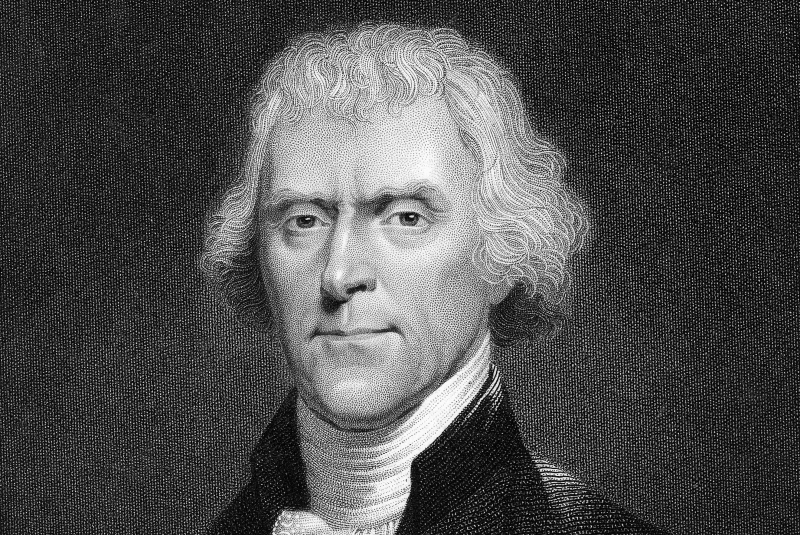
www.history.com 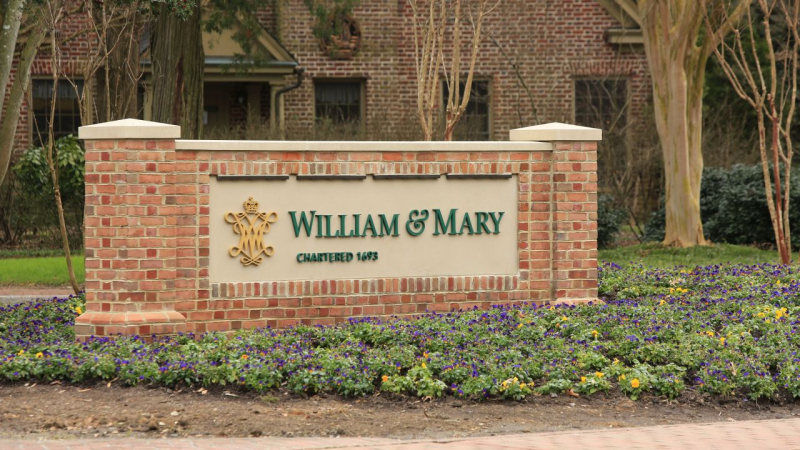
www.wm.edu -
After graduating, working as a law clerk at Wythe's office, he read the law under his guidance in order to become a lawyer. George Wythe, a well-known attorney and judge, had a big influence on Jefferson's legal education. American lawyer and statesman George Wythe was. He was a signer of the Declaration of Independence and the College of William & Mary's first professor of law. Wythe had a key role in early American history, and his works and ideas continue to have a big influence on people today.
He also read a wide range of political writings including English classics. Along with law and philosophy, Jefferson was well-read in a wide range of disciplines, including history, natural law, natural religion, ethics, and various branches of science, including agriculture. He generally drew heavily from the philosophers. Wythe oversaw Jefferson's years of study during which time he compiled a list of his copious readings in his Commonplace Book. Wythe left Jefferson his whole collection as a result of his admiration for Jefferson.
After finishing his education, Jefferson went back to Virginia and started a law practice. In 1767, Jefferson was admitted to the Virginia bar and resided at Shadwell with his mother. From 1769 to 1775, Jefferson served as a delegate for Albemarle County in the Virginia House of Burgesses. He immediately established a reputation for being a top attorney and rose to become one of the most in-demand attorneys in the state.
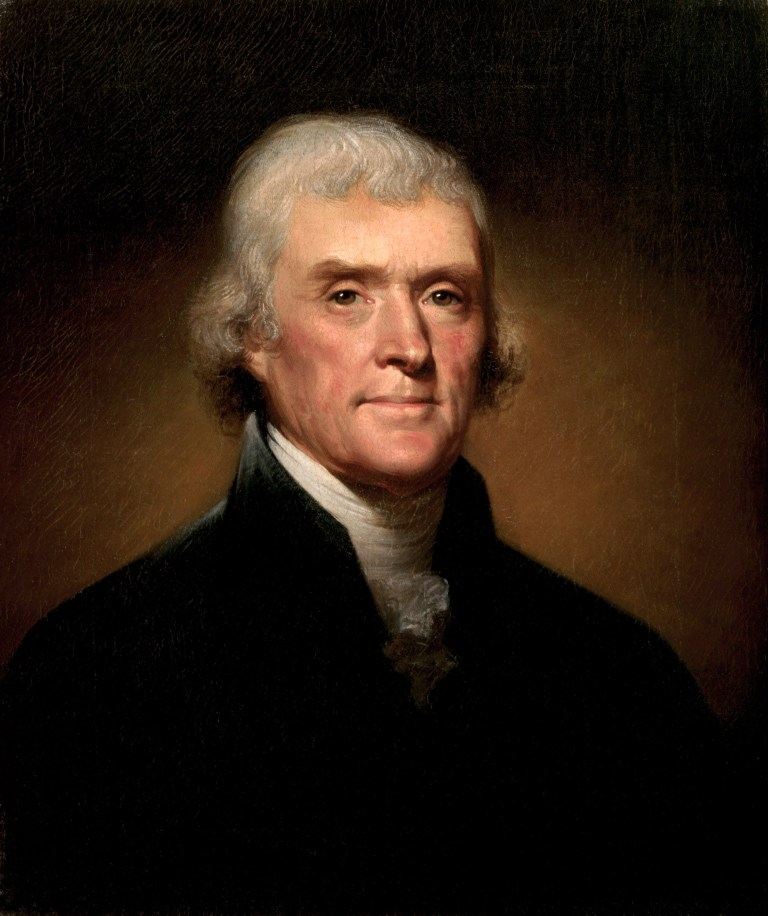
www.history.com 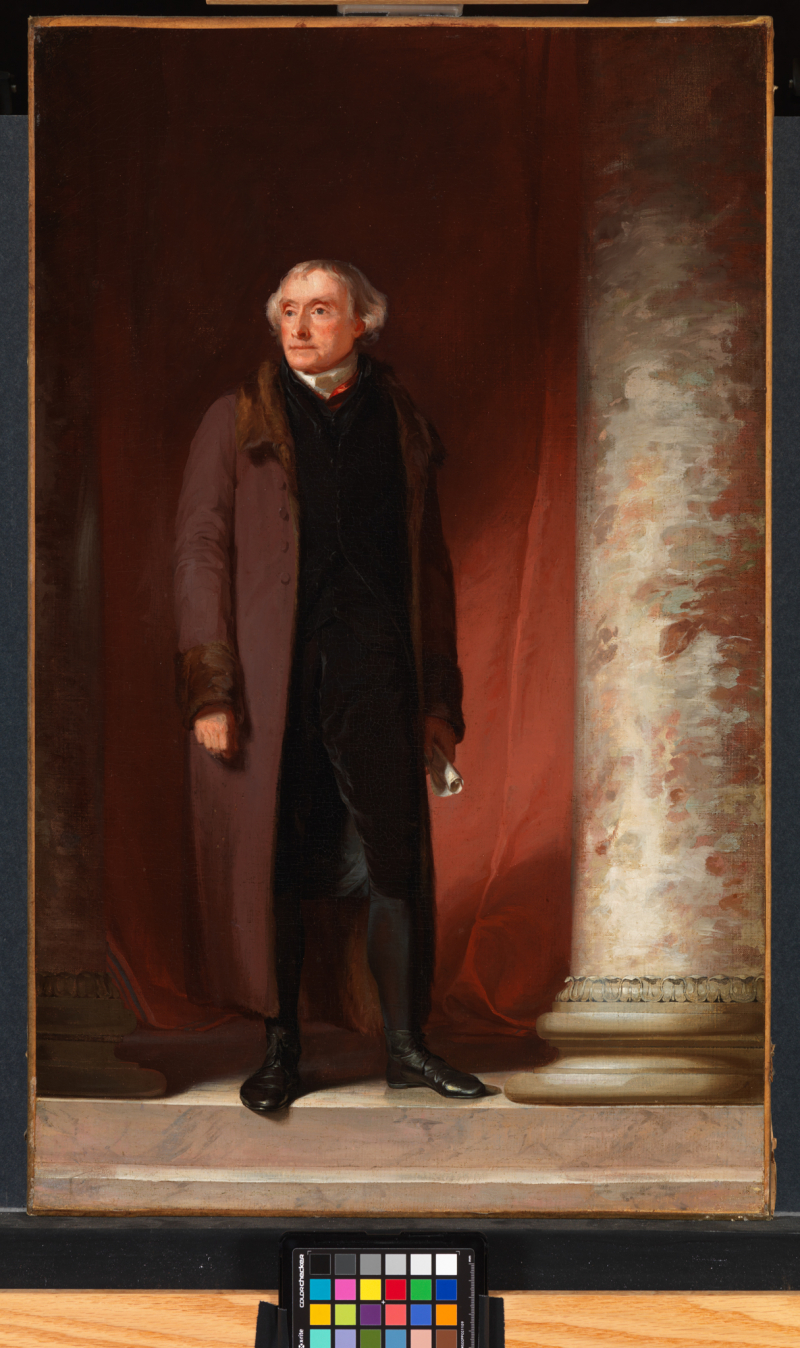
www.history.com -
Because he was eager to understand more about American history, Jefferson became interested in archaeology, which is one of the interesting facts about Thomas Jefferson. He thought we might learn more about the ancestry of the American people via archaeology. Jefferson is known as the "Father of American Archaeology" and the "First American Archaeologist" due to his excavation of the Indian mound. He "anticipates the essential approach and the methodology of modern archaeology by approximately a full century" with his methodical trenching and use of stratigraphy (i.e., stratigraphic observation) during his study of the Indian mound.
Jefferson had a lifelong interest in the native Indians of Virginia, and his response to Query XI has an outstanding account of the many Indian tribes, including their numbers, histories, locations, and languages. In his reply, Jefferson went into great detail about his investigation of an Indian burial mound in the Monticello "neighborhood." It was "located on the level terrain of the Rivanna, some two miles above its main fork, and opposed to some hills, on which had been an Indian settlement," according to him.
Jefferson went on to make a perpendicular incision through the body of the barrow so can see inside and see what was within. This opened to the previous earth's surface, passed approximately three feet from its center, and was broad enough for a man to go inside and study its sides. The bones he found were arranged in many layers, with the bones closest to the surface showing the least amount of degradation. He "conjectured that in this barrow could have been a thousand skeletons." No signs of violence, such as gunshot or arrow wounds, were seen on the bones. The second discovery disproved the theory that the warriors whose corpses were found in the mounds had died in combat. Jefferson also discovered that the bodies had not been positioned upright as some had assumed based on a local Indian legend. Besides, Jefferson had an unquenchable interest in natural history. He was a fossil collector and had a serious mammoth obsession. He seemed to like talking about them to everyone who would listen. He also shelled out some cash to have mastodon tusks and teeth shipped to him. Jefferson was similarly persuaded that mammoths and other extinct megafauna were still there in the unexplored West. Even when Lewis and Clark went on their illustrious voyage, the third president expected to find evidence of these species.
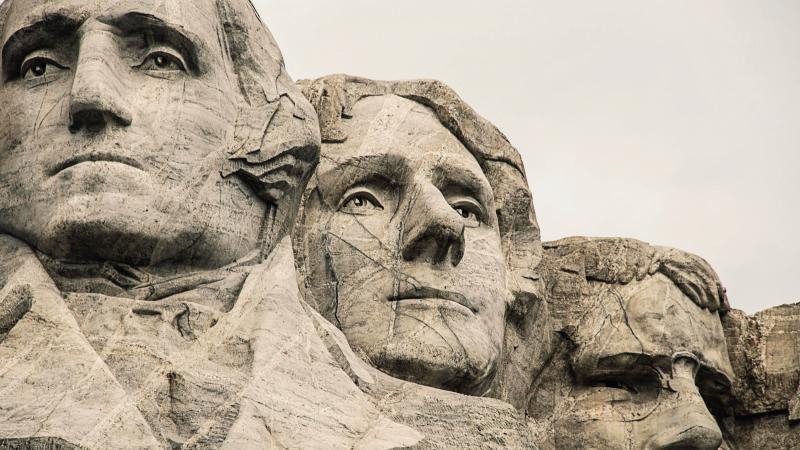
www.history.com 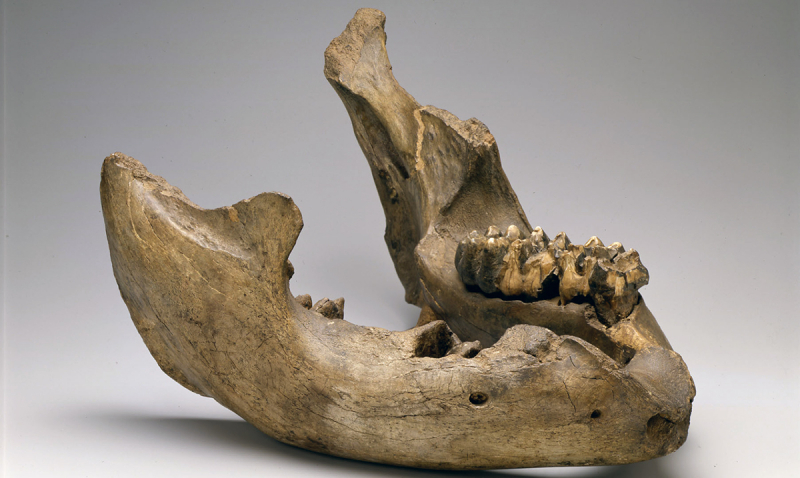
Mastodon tooth from Thomas Jefferson's collection -- www.monticello.org -
Jefferson was in charge of designing the Federal City in Washington, D.C. while serving as Secretary of State. Working with Major Pierre Charles L'Enfant, Jefferson had a hand in choosing the designs for many of the earliest governmental structures in the United States. By "providing them with models for their study and imitation," Jefferson took advantage of the occasion to "improve the taste of his compatriots." He stated that it was "a fortunate chance of introducing into the state an example of architecture in the classic style of antiquity" when he was chosen to design the Virginia State Capitol, for instance. Federal structures helped establish the neoclassical style in America in part thanks to Jefferson's design influence. Because of this, Fiske Kimball, an architectural historian, referred to Jefferson as "the founder of our national architecture."
Jefferson not only planned public structures but also numerous private Virginia houses, frequently for friends, including Monticello. Monticello, which is Italian for "Little Mountain," was built by Thomas Jefferson as his principal house in 1768. It was situated on a mountaintop with a view of his 5,000-acre plantation. He was cited as stating, "Architecture is my joy and putting up, and tearing down, is one of my favorite amusements." He spent most of his adult life creating Monticello. Local carpenters and masons worked mostly on the construction, with help from Jefferson's slaves. In 1770, he relocated to the South Pavilion. His ongoing goal was to create a Palladian-style neoclassical masterpiece at Monticello.
Along with the Monticello design, Virginia University is also one of his famous designs. The architectural forms of ancient Greece and Rome were highly regarded by Jefferson as being the most symbolic of American democracy. The library's "Rotunda" was based on the Roman Pantheon, and each academic building, known as a pavilion, had a two-story temple façade. Jefferson referred to the campus's grounds as the "Academical Village," and he used its design to express his ideas about education. The 10 pavilions, which formed a square and were connected by colonnades with the rows of dormitories for the students behind them, included classrooms and faculty housing. To emphasize the significance of the rural lifestyle, gardens and vegetable plots were positioned behind the pavilions and were enclosed by serpentine walls. The university's central building was a library rather than a cathedral, highlighting its secular nature.
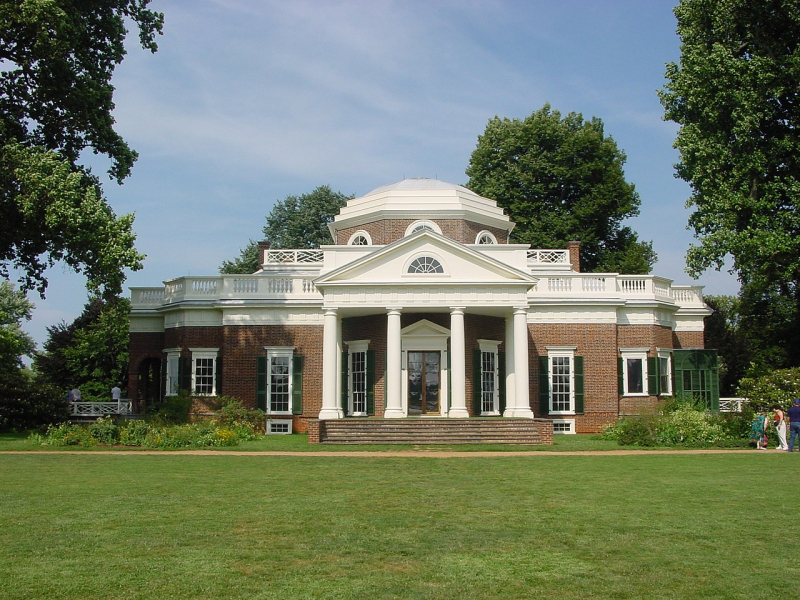
Jefferson’s Monticello -- www.history.com 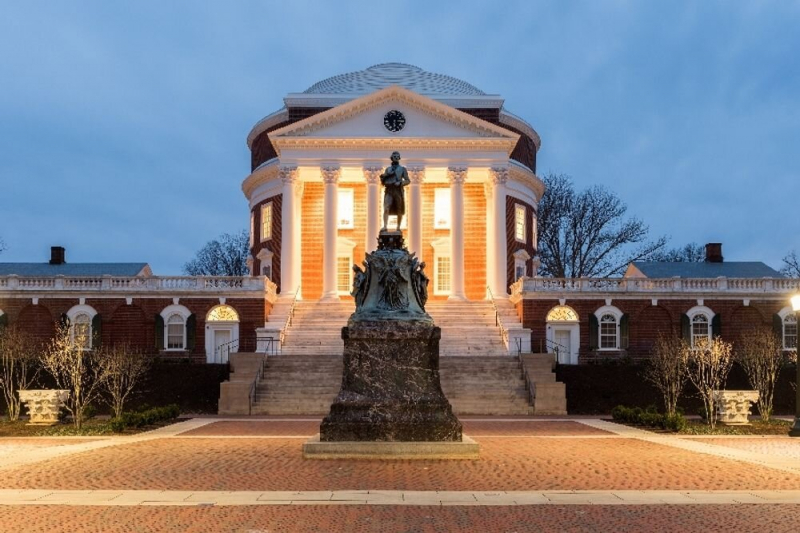
Virginia University -- www.campusreform.org -
To commence his duties as America's Minister to France, Jefferson traveled to Paris in 1785. Soon after, he arranged an official three-month trip to Piedmont, Bordeaux, Burgundy, and Rhone in southern France and northern Italy. As he became well acquainted with the centuries-old customs involved in cultivating and crafting the distinctive wines of each area, this journey opened his eyes to the finer side of wine and eventually molded his taste. From that, he came one of the first defenders of wine in America, Thomas Jefferson loved the beverage. He was a skilled winemaker who also played a key role in developing the nation's first wine business.
Additionally, Jefferson owned two vineyards at his house, Monticello, and was known for making fine wines. A cider room was situated next to a wine cellar that was 17 1/2 feet long, 15 feet broad, and 10 feet high. His 1769 Shadwell wine inventory, which included 83 bottles of rum, 15 bottles of Madeira, four bottles of "Lisbon wine for general use," and 54 bottles of cider, shows that he had an early interest in wine. Over time, however, this inventory would drastically shift. Jefferson's wines earned a reputation for being of excellent quality and delectable, and they were regarded as some of the best in the nation. He even offered George Washington some of his wines since he was so proud of them. Thomas Jefferson loved eating as well. He loved trying out different foods and was highly interested in cooking. He was known for cooking wonderful dishes and frequently hosted dinner parties at his house.
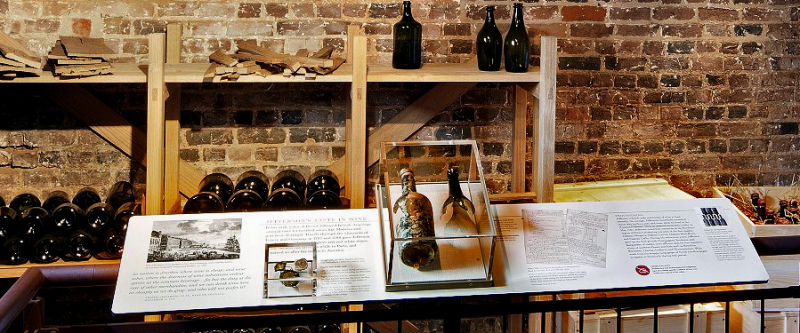
Monticello's Wine Cellar -- www.monticello.org 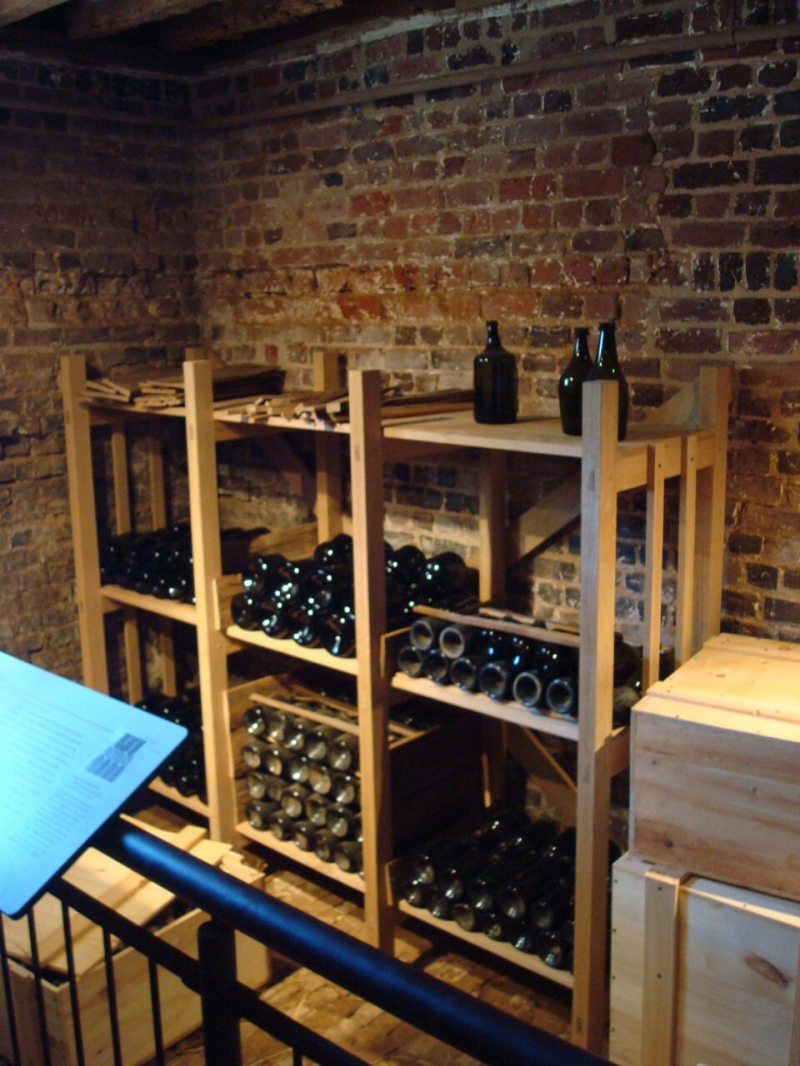
www.monticello.org -
In addition to being a magnificent human being, Thomas Jefferson was a skilled reader and writer, that is one of the interesting facts about Thomas Jefferson. He developed one of the world's greatest personal libraries due to his obsession with reading. Jefferson loved reading and built up three libraries throughout his lifetime. The first, a 200-volume collection he had established when he was young and comprised both books left to him by George Wythe and those he had inherited from his father, was destroyed in a fire that gutted his Shadwell house in 1770. Nevertheless, by 1773 he had added 1,250 new titles to his collection, and by 1814 it had over 6,500 volumes. His extensive collection of books was arranged into three main groups that mirrored the three functions of the human mind: memory, reason, and imagination.
He sold this second library to the American government for $23,950 to help the Library of Congress collection get off the ground after the British destroyed it during the Burning of Washington. Jefferson paid off part of his substantial debt with a share of the proceeds from the sale, sending $10,500 to William Short and $4,870 to John Barnes of Georgetown. But shortly after, he started buying books again for his collection, telling John Adams, "I cannot live without books." He started building a new library of his picks, it contained about 2,000 books. Jefferson's library was auctioned at auction after his death, and the British government bought it. After some time, the collection was brought back to the country and used to establish the Library of Congress.
During his lifetime, Thomas Jefferson wrote a lot. He wrote several important documents, including the Declaration of Independence and the Virginia Statute for Religious Freedom, in addition to his numerous letters and speeches. Jefferson was a talented writer with a straightforward and lyrical writing style. He was highly renowned for his skill with irony and sarcasm, as well as his use of metaphors and similes. As a master of rhetoric, Jefferson regularly employed rhetorical strategies to strengthen his arguments. Because of his writing prowess, Jefferson's books have had an enduring influence on American political philosophy.
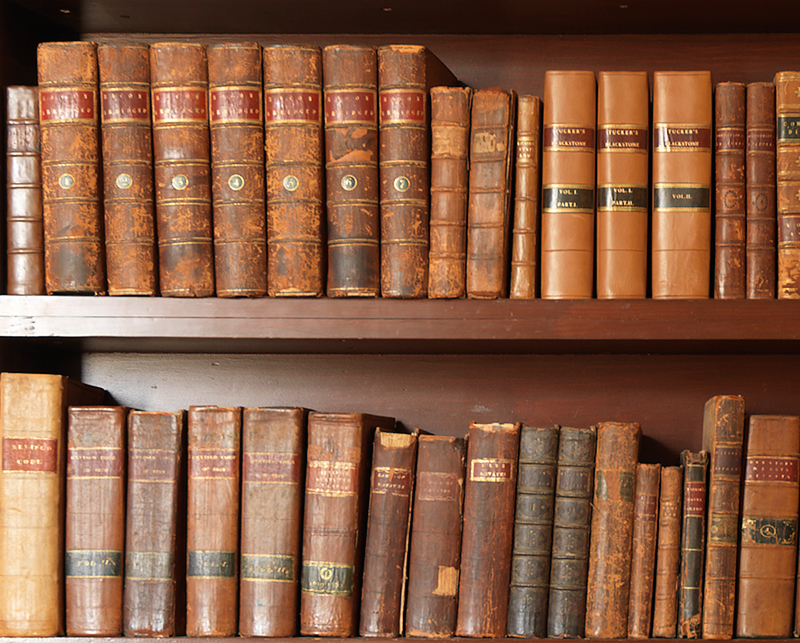
Books on shelves built according to Jefferson's specifications -- www.monticello.org 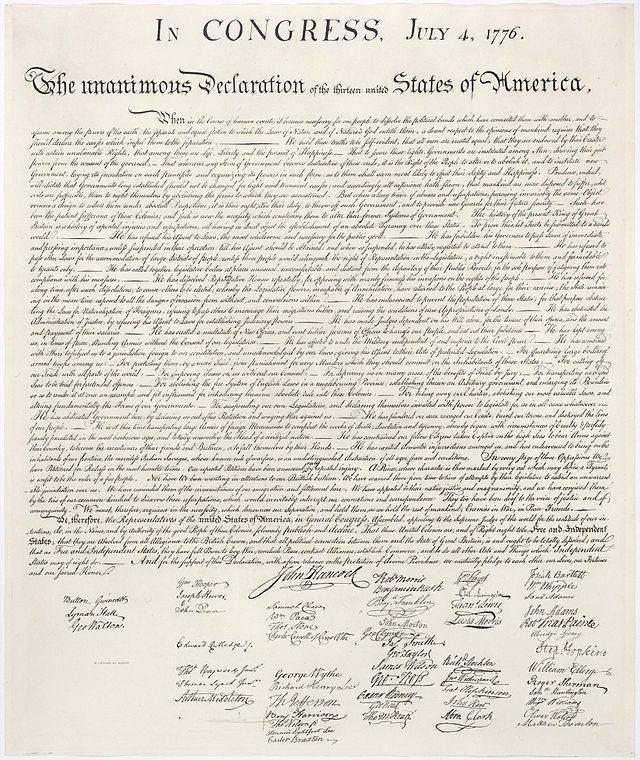
The Declaration of Independence -- www.aspeninstitute.org -
One of the interesting facts about Thomas Jefferson is he was an economist. Jefferson had a strong interest in economic theory, which he had grown to like while living in France. Leading European thinkers considered him a friend and translator. He supported free market principles and disapproved of the use of bank notes as money. He was one of the first proponents of laissez-faire economics and supported markets with less regulation. According to laissez-faire economics, allowing firms to run free from government interference is the greatest method to stimulate economic growth. One of the most well-known economic theories of the present day is laissez-faire economics, commonly referred to as free-market economics. The historical significance of Jefferson's economic theories is still being examined and discussed today.
For the point of view, Hamilton believed that Jefferson's plan was out-of-date and that the United States would remain impoverished under an agrarian economy. He thought that the new country needed to transition to the manufacturing and trade-based economy of the future in order to become a global power. Hamilton offered other recommendations for measures to advance the American economy in addition to his plan for banks, including protective tariffs for emerging industries (something many economists today would frown upon).
It is commonly known that Jefferson and Hamilton had a contentious disagreement about the national bank. The First Bank of the United States was created by Hamilton, who saw it as crucial to the funding of the federal government and the development of a strong domestic banking system. Hamilton is regarded as a central banking pioneer and an ancestor of the current Federal Reserve as a result. Jefferson thought the bank would give its owners too much control over the government. Actually, Jefferson had nothing good to say about banks. He was adamant that working the land was the only "honest" method to make a living, and he didn't trust bankers since he considered them as fundamentally swindlers.
Since the United States has the largest industrial economy in the world and only a small portion of the population still lives on farms, it is tempting to see Hamilton's subsequent role in American history as a victory. After all, as with banking, this is because the country is still primarily a land of plenty. From the Homesteading movement to contemporary notions of "local self-reliance," the Jeffersonian vision continues to have a strong hold on the American soul. Though there are many more, agricultural policy serves as a prime illustration of this mentality in action today. The main goal of these initiatives is to aid small, family farmers, at least in principle.
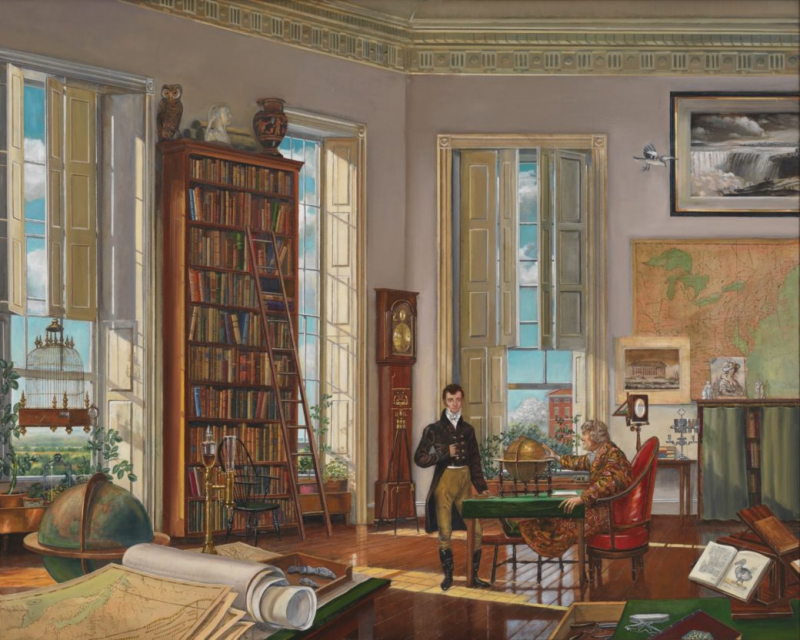
www.history.com 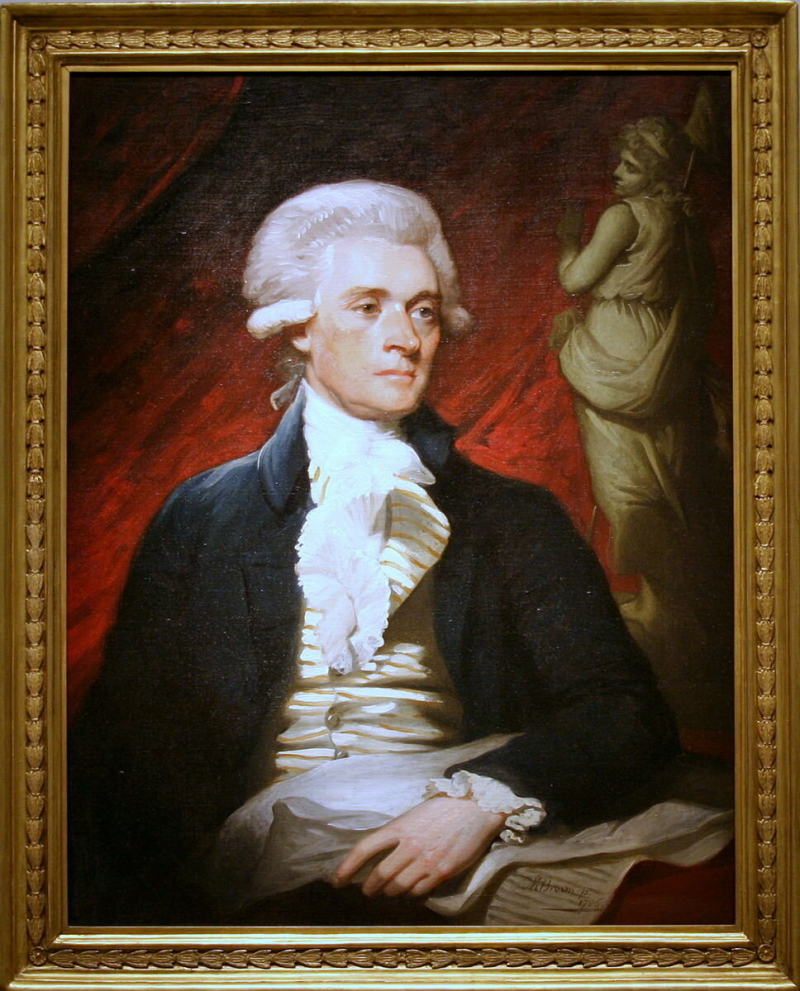
www.history.com -
Thomas Jefferson was a multi-talented individual. He was not just a politician, but also a talented musician. He was a musician who excelled in the violin and cello, as well as singing. In actuality, one of Thomas Jefferson's greatest loves in life was music. When Jefferson started playing the violin, it must have been when he was a young boy since, by the time he was fourteen, he was copying his favorite songs into music books. He once took lessons from Francis Alberti, an Italian immigrant residing in Williamsburg, after graduating from the College of William & Mary and before beginning his legal studies. To rehearse without disturbing his family, he even had a dedicated room created. He frequently organized musical evenings at his house. Even though developed music was in its infancy in the colonies, Jefferson was able to assemble a group that included a violinist named John Tyler and a harpsichordist named Robert Carter.
Even after he was elected president, Jefferson's passion for music persisted. He routinely invited musicians to the White House to play for him and his visitors when he was in office. Jefferson is to be credited for the White House's longstanding reputation as an arts-friendly location. Combining the cultured (classical, consequently European) with the popular/vernacular/rustic is one of Jefferson's musical life's themes, which would eventually prove to be essentially American. The various country fiddle melodies and dances with a unique Scotch-Irish twang that was popular in the backwoods of Virginia were no match for Jefferson, who could and did play classical sonatas on his violin.
Although Thomas Jefferson's contributions to music are debatably few, he insisted on music education at the University of Virginia he had just started, demonstrating the importance of music in civilized and humanistic existence. This demonstrates the value Jefferson placed on music in their intellectual life, just as his lifelong engagement with music reinforces his reputation as an ornament to American culture.
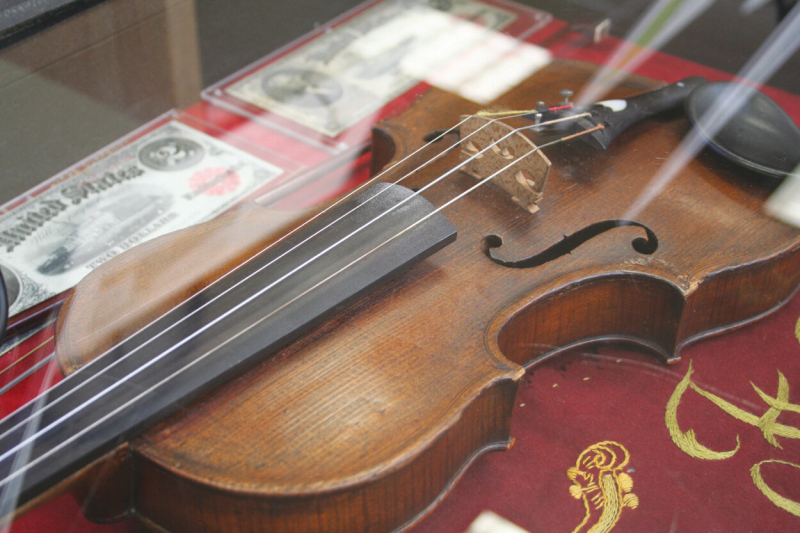
A violin owned by Thomas Jefferson -- www.cmuse.org 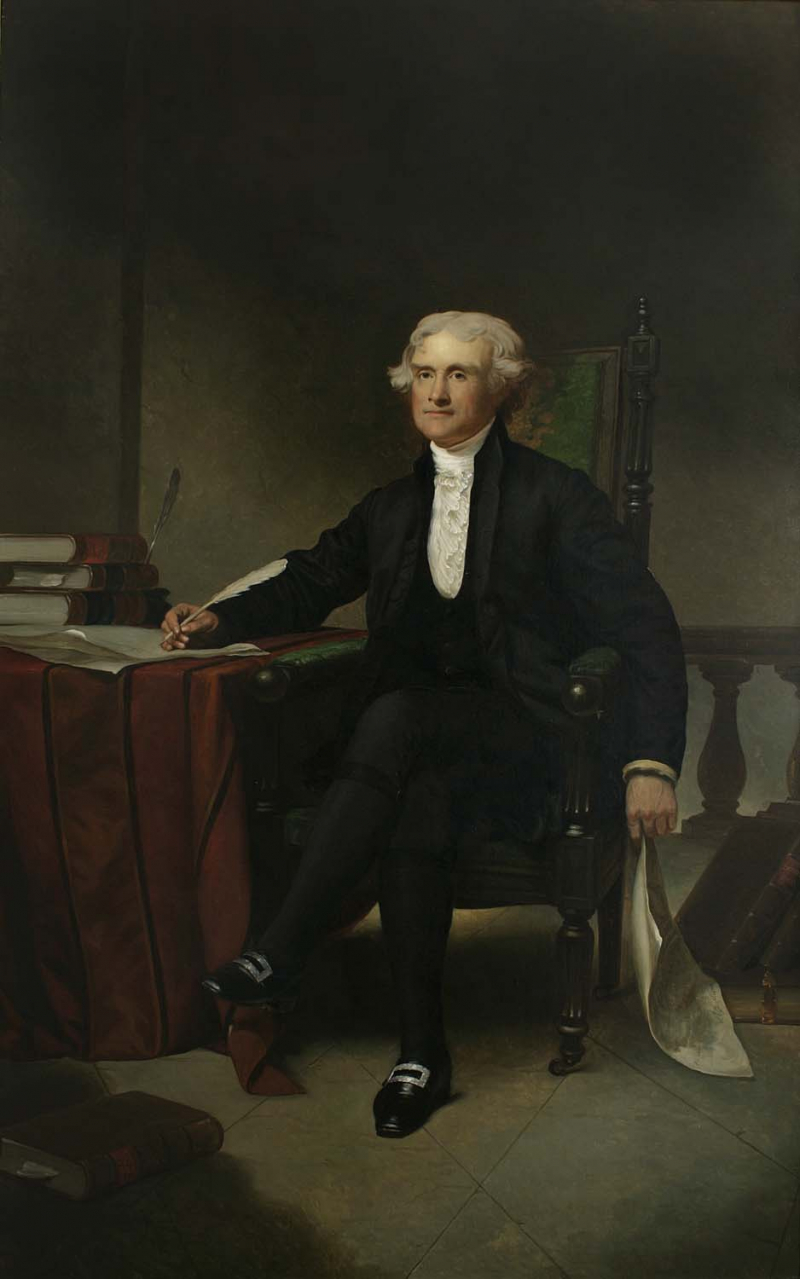
www.history.com -
In addition to serving as the third President of the United States, Thomas Jefferson was an amateur astronomer. He acquired a tiny telescope in 1769 and started stargazing. He instantly developed a fascination for the planets and stars and carefully observed their motions. Jefferson also exchanged letters with other astronomers, such as famed French researcher Pierre-Simon Laplace. Jefferson urged that astronomy be taught as part of the curriculum when he helped build the United States Military Academy at West Point in 1801.
For him, knowing one's place in the universe required having a thorough comprehension of the skies. Jefferson's Virginia estate, Monticello, still has a replica of his telescope standing today as a tribute to his passion for astronomy. The objective lens of the telescope in this image looks to be around two inches in diameter, and the telescope tube and mount are primarily composed of brass. Another telescope that Jefferson owned, known as a "micrometer," is also on exhibit at Monticello. This one belonged to Francis Hopkinson before being passed on to Thomas Jefferson. It was handed to Benjamin Franklin by the French astronomer Alexis Rochon. It has an Icelandic crystal 2-1/6-inch objective lens. Brass, leather, pressed board, paper, and cloth make up the telescopic tube, which folds from a length of 19 inches when open to 14 inches when closed.
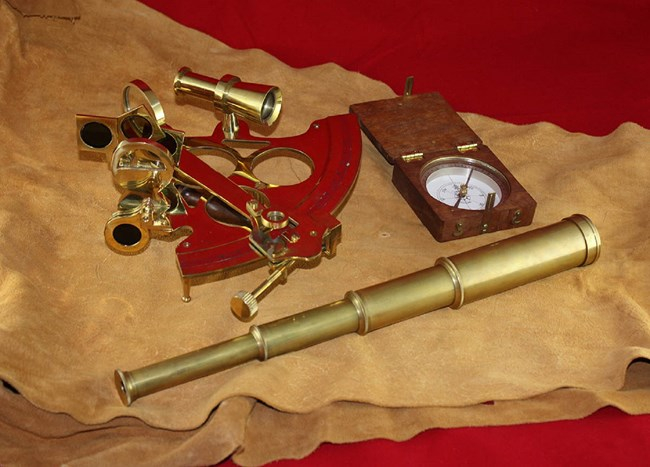
www.monticello.org 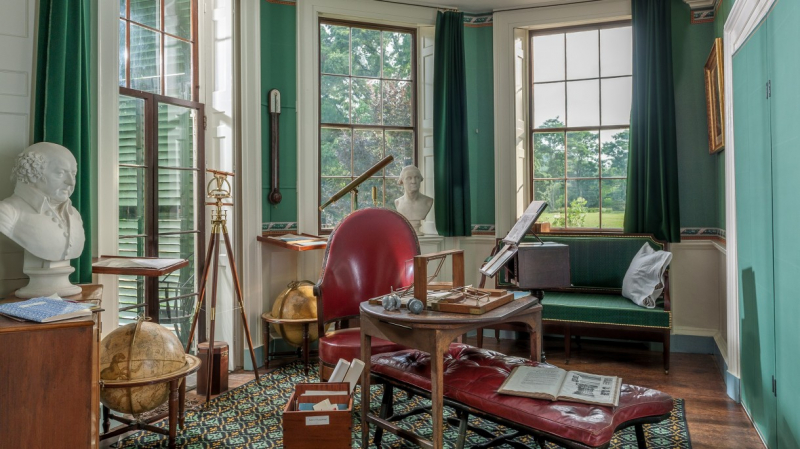
Jefferson's office at Monticello -- www.monticello.org -
Some of the technologies that Jefferson invented are still in use today. The Great Clock, which was made by Thomas Jefferson and presently adorns Monticello's entry hall, was one of his creations. Gravity operated a clock constructed of cannonballs that hung on each side of the entryway. The time was determined by observing the locations of the cannonballs' impacts with marks on the wall. A huge copper gong on the roof was attached to the Great Clock. A collapsible ladder that Jefferson created for clock maintenance was eventually used for tree trimming and fetching books from libraries. He also built a lap desk to hold all of the equipment and personal items he would require when working away from the workplace.
Jefferson is credited with creating new types of iron plows made specifically for hillside plowing, a macaroni machine, and a rotating chair with a leg rest and writing arm. He also created automated doors for his parlor as well as beds for his house that were placed into alcoves on rope webs suspended from hooks. A rotating book stand with adjustable book rests and motorized dumb waiters that let him bring wine up to the dining room from the basement were among the other things he designed for use in his house.
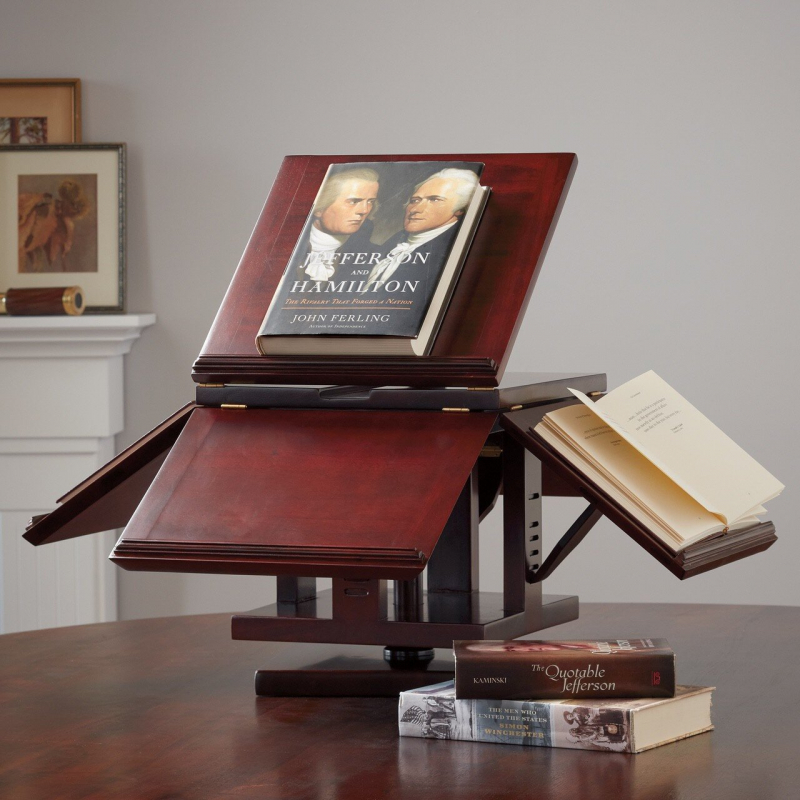
interestingengineering.com 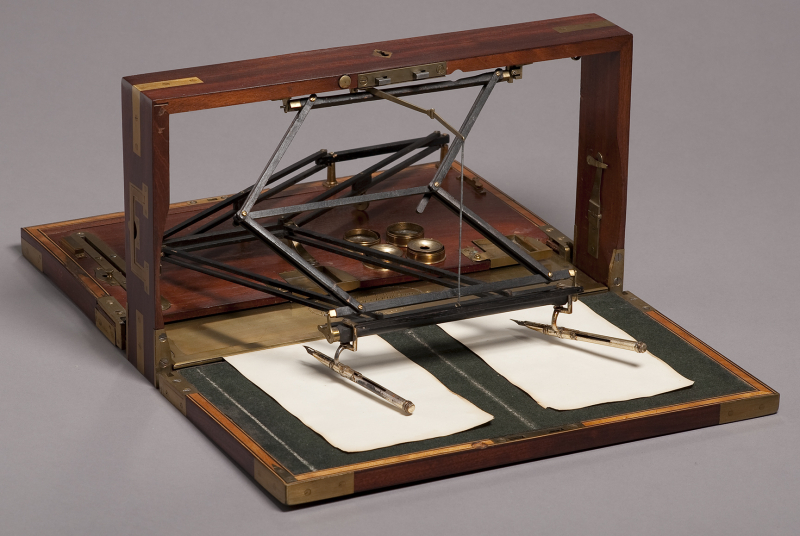
interestingengineering.com -
Due to a combination of rheumatism brought on my arm and wrist injuries, as well as digestive and bladder disorders, his health started to worsen in July 1825, and by June 1826, he was bedridden. Jefferson turned down a request from Washington to join the Declaration of Independence commemoration celebration on July 3 due to a fever. On July 4, 1826, the 50th anniversary of the signing of the Declaration of Independence, Jefferson passed away at Monticello at the age of 83. Coincidentally, Jefferson's friend, erstwhile opponent, and fellow Declaration of Independence signatory John Adams passed away on the same day. At Monticello, Jefferson was laid to rest. However, the former president's home, furnishings, and enslaved people were auctioned off after his passing because of the substantial debt he had racked up during his lifetime. In the end, a charitable organization bought Monticello, and in 1954, it was made accessible to the general public.
Jefferson is revered as the author of the Declaration of Independence, a key figure in the planning of the American Revolution, and a Renaissance man who advanced science and learning. He is seen as a symbol of individual liberty, democracy, and republicanism. His advocacy for enhanced voting rights and participatory democracy helped to define his period and set the bar for the next generations. According to Meacham, throughout the first half of the democratic republic's existence, Thomas Jefferson had the biggest impact, succeeded by presidential adherents James Madison, James Monroe, Andrew Jackson, and Martin Van Buren. Francis D. Cogliano refers to Jefferson's more than 18,000 letters of important political and philosophical content as "a documentary legacy... unmatched in American history in its number and scope."
Jefferson is still revered in America. Jefferson is honored with structures, statues, stamps, and money. In the 1920s, Jefferson was chosen by artist Gutzon Borglum and given the go-ahead by President Calvin Coolidge to be carved into stone at the Mount Rushmore Memorial with George Washington, Theodore Roosevelt, and Abraham Lincoln. On the 200th anniversary of Thomas Jefferson's birth, in 1943, Washington, D.C., held a dedication ceremony for the Jefferson Memorial. Rudulph Evans' 19-foot (6-meter) statue of Thomas Jefferson and engravings of quotes from his writings may be found inside the memorial. The inscription encircling the monument next to the roof that reads, "I have vowed upon the altar of God perpetual hatred against every kind of tyranny over the thought of man," is the most noticeable.
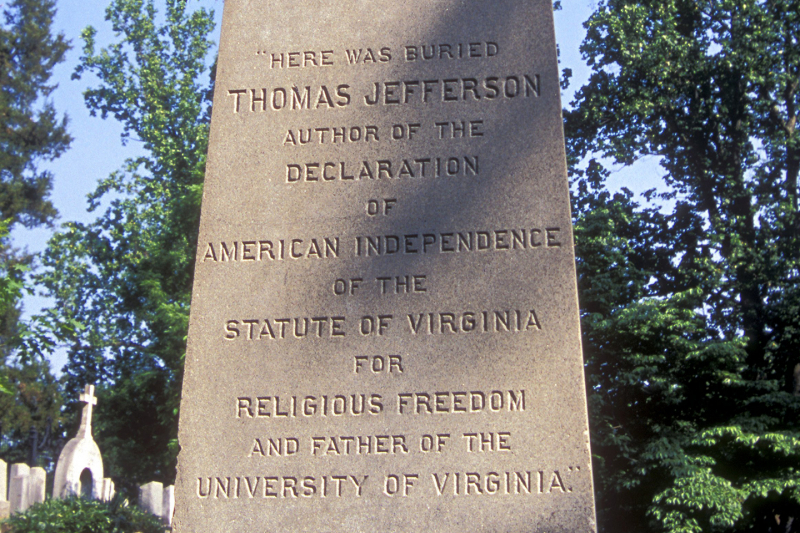
www.monticello.org 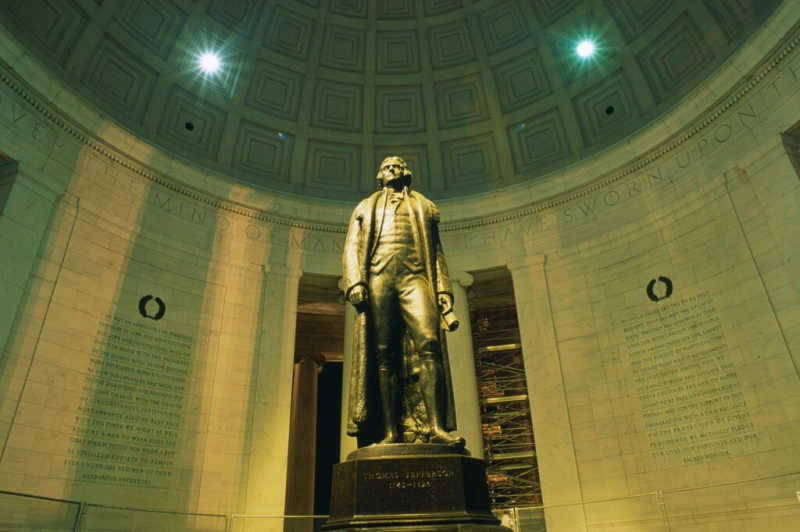
www.monticello.org













